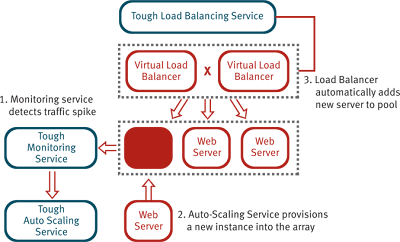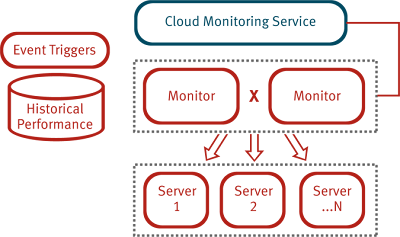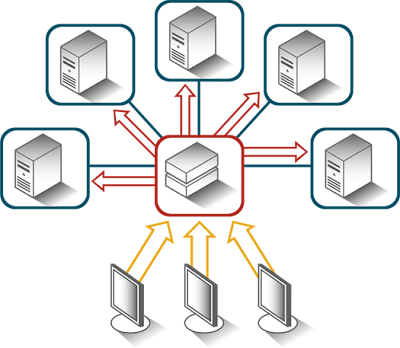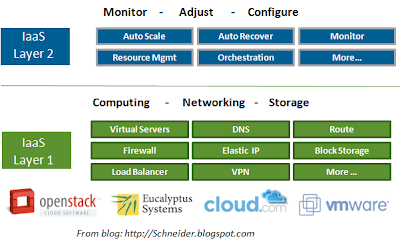In the early days of cloud computing emphasis was placed on 'one size fits all'. However, as our delivery capabilities have increased, we're now able to deliver more product variations where some products provide the same function (e.g., storage) but deliver better performance, availability, recovery, etc. and are priced higher. I.T. must assume that some applications are business critical while others are not. Forcing users to pay for the same class of service across the spectrum is not a viable option. We've spent a good deal of time analyzing various cloud configurations, and can now deliver tiered classes of services in our private clouds.
Reviewing trials, tribulations and successes in implementing cloud solutions, one can separate tiers of cloud services into two categories: 1) higher throughput elastic networking; or 2) higher throughput storage. We leave the third (more CPU) out of this discussion because it generally boils down to 'more machines,' whereas storage and networking span all machines.
Higher network throughput raises complex issues regarding how one structures networks – VLAN or L2 isolation, shared segments and others. Those complexities, and related costs, increase dramatically when adding multiple speed NICS and switches, for instance 10GBase-T, NIC teaming and other such facilities. We will delve into all of that in a future post.
Tiered Storage on Private Cloud
Where tiered storage classes are at issue, cost and complexity is not such a dramatic barrier, unless we include a mix of network and storage (i.e., iSCSI storage tiers). For the sake of simplicity in discussion, let's ignore that and break the areas of tiered interest into: 1) elastic block storage (“EBS”); 2) cached virtual machine images; 3) running virtual machine (“VM”) images. In the MomentumSI private cloud, we've implemented multiple tiers of storage services by adding solid state drives (SSD) drives to each of these areas, but doing so requires matching the nature of the storage usage with the location of the physical drives.
Consider implementing EBS via higher speed SSD drives. Because EBS volumes avail themselves over network channels to remain attachable to various VMs, unless very high speed networks carry the drive signaling and data, a lower speed network would likely not allow dramatic speed improvements normally associated with SSD. Whether one uses ATA over Ethernet (AoE), iSCSI, NFS, or other models to project storage across the VM fabric, even standard SATA II drives, under load could overload a one-gigabit Ethernet segment. However, by exposing EBS volumes on their own 10Gbe network segments, EBS traffic stands a much better chance of not overloading the network. For instance, at MSI we create a second tier of EBS service by mounting SSD on the mount points under which volumes will exist – e.g., /var/lib/eucalyptus/volumes, by default, on a Eucalyptus storage controller. Doing so gives users of EBS volumes the option of paying more for 'faster drives.'
While EBS gives users of cloud storage a higher tier of user storage, the cloud operations also represent a point of optimization, thus tiered service. The goal is to optimize the creation of images, and to spin them up faster. Two particular operations extract significant disk activity in cloud implementation. First, caching VM images on hypervisor mount points. Consider Eucalyptus, which stores copies of kernels, ramdisks (initrd), and Eucalyptus Machine Images (“EMI”) files on a (usually) local drive at the Node Controllers (“NC”). One could also store EMIs on an iSCSI, AoE or NFS, but the same discussion as that regarding EBS applies (apply fast networking with fast drives). The key to the EMI cache is not so much about fast storage (writes), rather rapid reads. For each running instance of an EMI (i.e., a VM), the NC creates a copy of the cached EMI, and uses that copy for spinning up the VM. Therefore, what we desire is very fast reads from the EMI cache, with very fast writes to the running EMI store. Clearly that does not happen if the same drive spindle and head carry both operations.
In our labs, we use two drives to support the higher speed cloud tier operations: one for the cache and one for the running VM store. However, to get a Eucalyptus NC, for instance, to use those drives in the most optimal fashion, we must direct the reads and writes to different disks,– one drive (disk1) dedicated to cache, and one drive (disk2) dedicated to writing/running VM images. Continuing with Eucalyptus as the example setup (though other cloud controllers show similar traits), the NC will, by default, store the EMI cache and VM images on the same drive -- precisely what we don't want for higher tiers of services.
By default, Eucalyptus NCs store running VMs on the mount point /usr/local/eucalyptus/???, where ??? represents a cloud user name. The NC also stores cached EMI files on /usr/local/eucalyptus/eucalyptus/cache -– clearly within the same directory tree. Therefore, unless one mounts another drive (partition, AoE or iSCSI drive, etc.) on /usr/local/eucalyptus/eucalyptus/cache, the NC will create all running images by copying from the EMI cache to the run-space area (/usr/local/eucalyptus/???) on the same drive. That causes significant delays in creating and spinning up VMs. The simple solution: mount one SSD drive on /usr/local/eucalyptus, and then mount a second SSD drive on /usr/local/eucalyptus/eucalyptus/cache. A cluster of Eucalyptus NCs could share the entire SSD 'cache' drive by exposing it as an NFS mount that all NCs mount at /usr/local/eucalyptus/eucalyptus/cache. Consider that the cloud may write an EMI to the cache, due to a request to start a new VM on one node controller, yet another NC might attempt to read that EMI before the cached write completes, due to a second request to spin up that EMI (not an uncommon scenario). There exist a number of ways to solve that problem.
The gist here: by placing SSD drives at strategic points in a cloud, we can create two forms of higher tiered storage services: 1) higher speed EBS volumes; and 2) faster spin-up time. Both create valid billing points, and both can exist together, or separately in different hypervisor clusters. This capability is now available via our Eucalyptus Consulting Services and will soon be available for vCloud Director.
Next up – VLAN, L2, and others for tiered network services.



